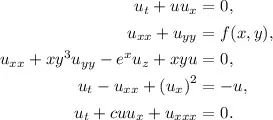
A First Course in Partial Differential Equations
J Robert Buchanan, Zhoude Shao
- 624 pagine
- English
- ePUB (disponibile sull'app)
- Disponibile su iOS e Android
A First Course in Partial Differential Equations
J Robert Buchanan, Zhoude Shao
Informazioni sul libro
-->
This textbook gives an introduction to Partial Differential Equations (PDEs), for any reader wishing to learn and understand the basic concepts, theory, and solution techniques of elementary PDEs. The only prerequisite is an undergraduate course in Ordinary Differential Equations. This work contains a comprehensive treatment of the standard second-order linear PDEs, the heat equation, wave equation, and Laplace's equation. First-order and some common nonlinear PDEs arising in the physical and life sciences, with their solutions, are also covered.
This textbook includes an introduction to Fourier series and their properties, an introduction to regular Sturm–Liouville boundary value problems, special functions of mathematical physics, a treatment of nonhomogeneous equations and boundary conditions using methods such as Duhamel's principle, and an introduction to the finite difference technique for the numerical approximation of solutions. All results have been rigorously justified or precise references to justifications in more advanced sources have been cited. Appendices providing a background in complex analysis and linear algebra are also included for readers with limited prior exposure to those subjects.
The textbook includes material from which instructors could create a one- or two-semester course in PDEs. Students may also study this material in preparation for a graduate school (masters or doctoral) course in PDEs.
-->
Request Inspection Copy
--> Contents:
- Introduction
- First-Order Partial Differential Equations
- Fourier Series
- The Heat Equation
- The Wave Equation
- The Laplace Equation
- Sturm–Liouville Theory
- Special Functions
- Applications of PDEs in the Physical Sciences
- Nonhomogeneous Initial Boundary Value Problems
- Nonlinear Partial Differential Equations
- Numerical Solutions to PDEs Using Finite Differences
- Appendices:
- Complex Arithmetic and Calculus
- Linear Algebra Primer
-->
--> Readership: Mathematics, physical and life sciences, and engineering undergraduate students interested in partial differential equations. -->
Keywords:Heat Equation;Wave Equation;Laplace's Equation;Poisson's Equation;Applications of PDEs;Fourier Series;Sturm–Liouville Theory;Special Functions;Finite Difference Techniques;Nonlinear PDEs;Duhamel's Principle;Maximum/Minimum PrincipleReview: Key Features:
- It is written for undergraduate science and mathematics students as a self-contained introduction to the field of PDEs assuming only a prerequisite background in ordinary differential equations. This textbook is appropriate for readers in mathematics, the physical and life sciences, and engineering. The style of writing is clear and easily accessible to the student. After successfully completing a study of PDEs in the proposed textbook, students will be prepared for more advanced study in PDEs
- The treatment of topics is precise and rigorous, to the extent that it is accessible to the typical undergraduate science and mathematics student. For the topics where rigorous mathematical treatment is beyond the scope of the book, references to more advanced and precise treatments are provided
- The first six chapters of the textbook (five chapters if an instructor elects to omit the chapter on first-order PDEs) provide a standard undergraduate introduction to PDEs and their solution techniques and can be delivered in a typical one-semester course. The material from the remaining six chapters of the textbook can form a second-semester course in PDEs or material for independent study
Domande frequenti
Informazioni
Chapter 1
Introduction

1.1Preliminaries: Notation, Definitions, and the Principle of Superposition



